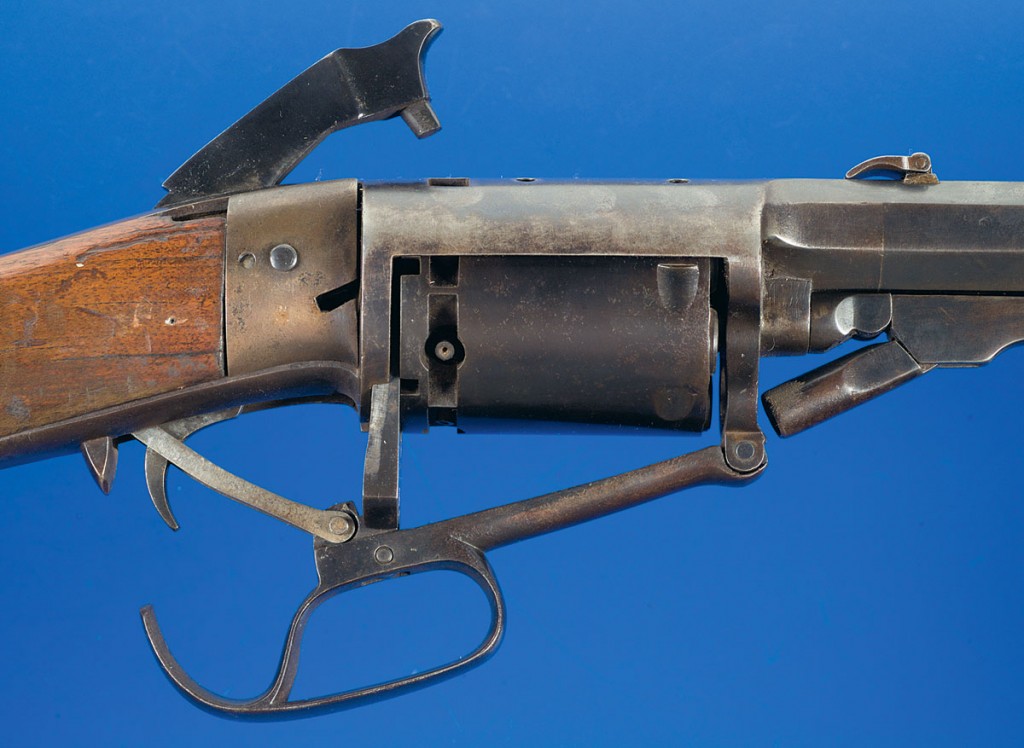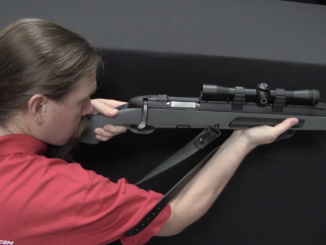The North & Skinner was an early 6-shot percussion-fired revolving rifle design. Its design was patented in 1852 by Henry North and Chauncy Skinner (US Patent #8982), and the guns were manufactured from 1856 to 1859 by the Savage & North company (which was Henry North and Edward Savage – not the Arthur Savage who developed the Savage 99). About 600 of these guns were made in total, with roughly 20% being .60-caliber shotguns and the remainder .44 caliber rifles. Unlike many revolving rifle designs, the North & Skinner functioned as a lever action, with the trigger guard serving as lever.

The North & Skinner design also included several features intended to protect the shooter from the cylinder gap blast (which was a significant problem with all such revolving rifle designs). It used recessed chambers and a locking wedge that would push the cylinder forward to achieve a semblance of a gas seal (a bit like the 1895 Nagant revolver). How well this worked, I have not been able to determine – perhaps one of these days I will find an example of the gun that I can shoot and find out.
There was a North & Skinner at the September 2013 Rock Island Auction, and I took some video footage of it:



Well, that’s one way to solve cylinder gap blast in a revolving rifle… though I have a feeling that the receiver itself here would take care of the problem on its own.
Savage produce also revolver known as “Savage Navy revolver”, which also featured lever-operating and gas-sealing
http://armscollectors.com/mgs/savage_north.htm
While the gun might not blow itself to bits in the event of a chain fire, I would hate to imagine the state of the user’s forehand on the stock should the barrel have been grasped…
To quote (or paraphrase a quote by) R. Lee. Ermey,
“This is my hand, I like my hand. I don’t wanna shoot my hand!”
Even worse: If a chain fire happened on the first shot, the camming rammer would be lost…
if a chain fire happened on the first shot i can imagine that it’s going to be an unpleasant experience
but how much energy would the projectiles have , they didn’t go thru the barrel so it can’t be an enormous amount
also how do chain fires happen the lead ball and patch seal the chamber in the cilinder ?
In theory yes, but the seal isn’t perfect. Plus there’s the chance of loose gunpowder in the mechanism if you’re not careful when loading it.
Chainfires are bad no matter what they’re in…when you bottom centre goes, you will have a bad day. Cap tightly and grease liberally, though all the old timers I talk to say that chainfires happen through the back, which makes a lot of sense. Given that, looking at the nipple arrangement, this thing ought to be nearly immune.
To reduce the risk of hot gases blowing forward, what if you install a hollow forearm ahead of the cylinder?
Make the outside diameter about the same as the cylinder. That would keep the forward hand outside the trajectary of chain-fires.
One of the very few Internet references I’ve been able to find to White’s Union 76 truck stop in Virginia – the best public-display collection of firearms I’ve ever seen in a truck stop, if not anywhere – was a YouTube narrated by a tour guide who obviously had no idea what most of the thousands of weapons in the cases on the walls were. I recall that he was particularly “what the heck is that?” non-pulsed by the Savage Civil War pistol. Apparently the video was made not long before White’s closed. I wonder what happened to that incredible collection? There were dozens of equally odd vintage motorcycles in Lexan cubes outside. That must have been quite an auction.
I read somewhere – think it was in one of Bernard Cornwell’s “Starbuck Chronicles” Civil War novels – a warning that the user needed to disengage his middle finger from the lever before firing the revolver, as the recoil was a finger-breaker. If so, that would have cut down on rapid fire. Wasn’t aware it was a gas-sealer as well… what, 30 years before the Nagant?
Nice item. not many revolving rifles around. the rumer here is that itwas invented by a Peter Rasmussen from Langeland, and that S Colt visited him on his trip with Korvo, prior to the Pattersons
The inventors of revolver are not know, it is sure that S. Colt don’t invent revolver, but the Colt revolvers were first mass-produced and reliable revolvers. Examples of revolvers earlier than Colt:
http://en.wikipedia.org/wiki/Puckle_gun (18th century)
http://en.wikipedia.org/wiki/Elisha_Collier states that:”Samuel Colt saw weapons of this type [Collier flintlock revolvers] while serving as a cabin boy aboard the brig Corvo in 1832.”
Here’s a video of another cool pre-Colt revolver, which Jonathan Ferguson showed me at the Pattern Room collection:
https://www.forgottenweapons.com/pattern-room/
I believe I may own a very early version of this rifle. There is no finger hole for the middle finger, a different hammer, and definitely mfg by North and Skinner
Jeff, I too have an early one (serial #168) and am looking to find some info … if interested, I’ve collected a bunch of info on Simeon North’s factory, and Chauncey Skinner (the designer/patenter and my 4th gr-grandfather). Let me know if you’re interested in sharing info …
Thanks, Doug C.
Hi Doug. Thanks for the response. Not much was written about this rifle at the time I pitched it. Only thing out there was a James Julia auction blurb. Rifle sold for a few thousand dollars. I believe only around 650 of these were made. My barrel is stamped p 1865. I assume patent year. Definitely a wall hanger. I like the rarity of it. Would enjoy knowing more.
Jeff
Jeff,
Yup – On 01 June 1852, Henry S. North and Chauncey D. Skinner patented a sliding crotch (wedge) and rotating breech (cylinder assembly) designed to force the breech forward so the lip of the individual cylinder chambers would seat into the countersunk opening at the rear of the barrel creating a seal (US Patent No. 8982). This design was intended to restrict the loss of gas and pressure from the usual gap between the barrel and cylinder resulting in more effective propulsion of the bullet. It also restricted the escape of flame and hot gasses from the opening between the chamber and barrel which could lead to lateral fire of the adjacent chamber (chain-fire). This design was used on their revolving rifle which was stamped “North & Savage”. An estimated 600 were made during that time with approximately 450 being .44 caliber rifles, and the rest being shotguns (appx .60 / 18 gauge for use with small buckshot or ‘buck and ball’).
Here’s a pretty good video which shows some history as well as basic operation:
https://www.forgottenweapons.com/north-skinner-wedge-lock-revolving-rifle/
Any chance your barrel is stamped 1856 vice 1865 (typo above) and shows ‘E. Savage’ vice ‘North & Savage’? If so it would be much rarer! If not, then I’m not sure what you have as in 1864 the company (which had changed names a couple times) foundered for several reasons including poor management, lack of government contracts and lack of quality control with it’s inspectors. The company disbanded in 1866 selling all of its real estate holdings to Edward Savage (son of the brother-in-law of original owner Simeon North’s 1st wife who assumed his father’s interests as partner in 1831 and total ownership in 1856 after the passing of Simeon and his son in 1852 & 1856 respectively).
I can post a bunch more info on the rifle, company and development, or I can email you stuff if it’s not relevant to this post but is to your rifle (and I can’t figure out how to post pics on here).
Regards,
Doug
Sorry. Stamped 1852. Shouldn’t do this in the middle of the night.
My email is jeff@carmanplan.com